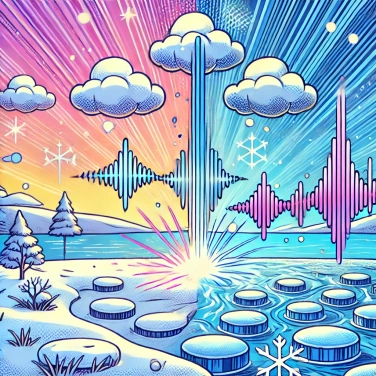Snow absorbs sound better than ice due to its porous structure and acoustic damping properties. The air microcrystals present in snow dissipate sound energy more effectively than compact ice.

Snow has a structure made up of tiny crystals loosely bonded together. These crystals are arranged irregularly, leaving many empty spaces filled with air. Ice, on the other hand, is like well-packed and frozen snow: it has a solid, compact structure, almost without space or porosity. As a result, snow is fluffy and full of small cavities, while ice is dense, homogeneous, and solid, with no small holes to trap sound. It is precisely these structural differences — texture, porosity, and arrangement of the crystals — that strongly influence their acoustic behavior.
Snow has a very porous structure, full of tiny air-filled spaces. When a sound travels through the snow, it enters these pores, bounces around, and gradually loses its energy. The air trapped in these tiny holes acts as a natural sound absorber. As a result, sounds are quickly muffled, unlike compact ice, which reflects them directly without weakening them much. That's why walking on a thick layer of fresh snow seems very silent, while walking on a frozen lake produces a clear and powerful sound that travels far.
Density plays a significant role in how sound travels through snow or ice. Fresh, airy, and low-density snow contains many air pockets. These spaces slow down sound waves and gradually decrease their energy, which quickly muffles the sound. In contrast, compact and dense ice allows sounds to pass through it with far fewer obstacles. As a result, ice reflects sounds more, while light snow acts like a large acoustic cushion. That’s why walking on fresh snow gives that unique sensation of calm and muffled silence.
Temperature affects acoustic properties because it alters the state of the snow. When it is colder, snow crystals are generally well-separated, fragile, with plenty of small air pockets. As a result, sound easily dissipates in these small spaces, and the snow absorbs noise better. Conversely, when temperatures become milder, the snow slightly melts, the crystals stick together, and the air pockets decrease. Consequently, the snow hardens, resembles ice more, and reflects sounds more instead of absorbing them. As the snow transforms according to the cold or thaw, it directly changes its ability to muffle or reflect sounds.
During the Winter Olympics, organizers use snow cannons to create artificial snow specifically designed to absorb more sound, thereby reducing acoustic distractions for athletes during competitions.
Igloos, often constructed from compact snow, have excellent acoustic insulation properties due to the numerous air cavities trapped between the snow grains.
Walking in fresh snow generates a muffled sound because its small crystals and pores effectively absorb and disperse sound vibrations, unlike a more compact icy surface that distinctly reflects sounds.
In architectural acoustics, some researchers draw inspiration from the porous structure of snow to design natural and environmentally friendly acoustic insulation panels.
Freshly fallen snow contains many空隙 filled with air, which allows for the absorption of sound waves. These spaces significantly reduce echo and ambient sounds, creating that particular sensation of silence.
No, the effectiveness of sound absorption depends on the quality, density, and temperature of the snow. Light, fresh snow with many air pockets will absorb sound better than wet, compacted snow.
When the temperature drops, the air becomes denser, which can affect the speed and distance at which sounds travel. Additionally, cold, dry snow will have a more absorbent effect than when temperatures rise and make the snow wet.
Ice has a dense and compact structure with very few porous spaces. This limits sound absorption and instead causes sound reflection, creating a livelier acoustic with increased reverberation.
Yes, a layer of snow can temporarily reduce urban noise pollution due to its ability to absorb sound, making the noises of traffic and daily activities less audible.

No one has answered this quiz yet, be the first!' :-)
Question 1/5